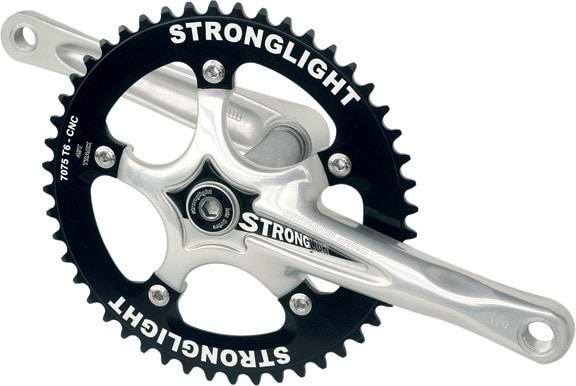Bike Chainset Buying Guide - Ribble Cycles
The chainset is part of a bicycle drivetrain that connects your chain to the cassette at the rear of the bicycle. Attached to the chainset are of course your pedals. It may seem a relatively simple component, but it can have a big influence on your riding.

What chainset is best for me?
The chainset comprises of the chainrings and the crank arms.You can buy these separately, but most customers buy the set. If you are simply upgrading your current chainset there are a couple of things to look at. Count the number of teeth on each chainring (known as the ratio), and also the length of the crank-arm. Most of the time, the length of the crank-arm is printed on the back near to where the pedal thread is, as in the picture.
| Rider Height | Crank Arm Length |
| Less than 5'1" | 165mm |
| 5'1" to 5'7" | 170mm |
| 5'7" to 5'11" | 172.5mm |
| 5'11" plus | 175mm |
Road chainsets usually vary from 165mm all the way up to 180mm, with 2.5mm increments in between. There is much debate about what length a rider should use and there are many articles about how to calculate this, but generally speaking it goes off your leg length and height. As a guide, this table shows suggested crank arm lengths;
Chainsets also fit different bottom bracket styles, and so it is important to check what type your bicycle uses. These vary from square-taper and Octalink, all the way to modern designs such as Hollowtech II and BB30.
Upgrading your chainset
There are three main brands of chainset: Shimano, Sram and Campagnolo. The difference between these is largely down to personal preference; functionality of the different products is very similar. We find most customers buy a brand consistent with the rest of their groupset to ensure compatibility and a consistent look.
Within a brand, the basic trade-off is price vs weight. So for example a Shimano Ultegra chainset will cost more than a Shimano 105, but will be lighter (48g lighter). Here are the current brands and product tiers (in increasing price / reducing weight order): Shimano: Tiagra, 105, Ultegra, Dura Ace; Sram: Apex, Rival, Force, Red; Campagnolo: Veloce, Athena, Chorus, Record, Super Record.
If your current chainset is compact (50/34), you can change it for a standard (52/39), but please bear in mind you will also need to adjust your chain length and front derailleur height. If you're upgrading like for like, i.e. replacing a 50/34 with a newer / lighter 50/34, you won't need to change anything else, but it is good practice to ensure all gears are running smoothly before heading out on a ride.
Road Chainsets
Compact Chainsets
Probably the most popular choice of chainset that we put onto our Ribble bikes, a compact chainset is one with a 34 tooth inner chainring and an outer with 50 teeth. They are a much better alternative to a triple chainset, as they offer a good range of gearing, whilst still keeping the chainline at its best. This improved chainline results in the chain being put under much less strain, and so can last longer.
A compact chainset is the ideal choice for the rider who rides sportives as it offers a good gear for any road, without sacrificing too much on top end speed.
Standard chainsets
This ratio of chainset is more for the rider who is an experienced climber, and able to push a harder gear. The chainrings on these are a 39 tooth inner, and usually a 53 tooth outer, resulting in gearing that is much more suited for racing.
Triple chainsets
The triple chainset is more of the choice of the touring cyclist nowadays. They have, as the name suggests, 3 chainrings, with the smallest one being much lower than that on compact or standard chainsets. The result is a very low gear, perfect for if your bicycle is loaded up with panniers, or you are climbing Ventoux everyday!
Track chainsets
 Stronglight Track Z Light Activ Link Chainset
Stronglight Track Z Light Activ Link Chainset
The demands of track cycling mean that a chainset needs to be made strong and as light as possible. They of course only have one chainring on them and it is worth checking to see if there are limits to the crank arm length you can use. This is because some velodromes such as the one at Manchester limit you to a maximum length of 165mm.
Mountain Bike chainsets
 Shimano M8000 Chainset
Shimano M8000 Chainset
These chainsets follow the same sort of pattern as the road bike ones mentioned above, with triple and double variants being offered by most of the manufacturers. Double chainsets are the most popular choice, but the gearing is lower to enable climbing over rougher and more unpredictable terrain.
The biggest development in mountain bike chainsets has been the introduction of single ring chainsets matched with a wide ratio cassette. They usually use new technology such as narrow/wide teeth which are designed to keep the chain from falling off, and result in a simple, fuss-free drivetrain.
Posted by

Andy Mc
Andy is the Product Specialist and Content Writer at Ribble. He takes part in all disciplines of cycling, but can mostly be found either on his road bike or on the mountain bike trails.
Customer Care
If you are in any doubt about what is best for you then our Cycling Experts can help via email or telephone
Email: [email protected]
Tel: +44 (0)1772 963400
